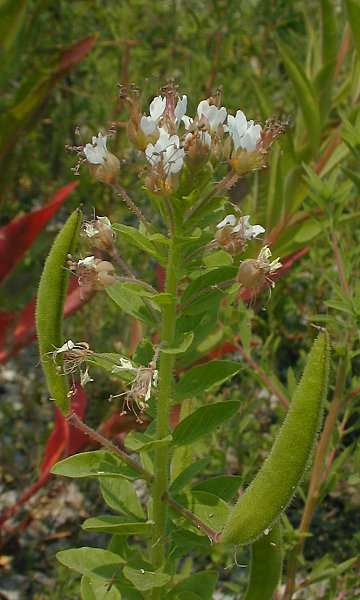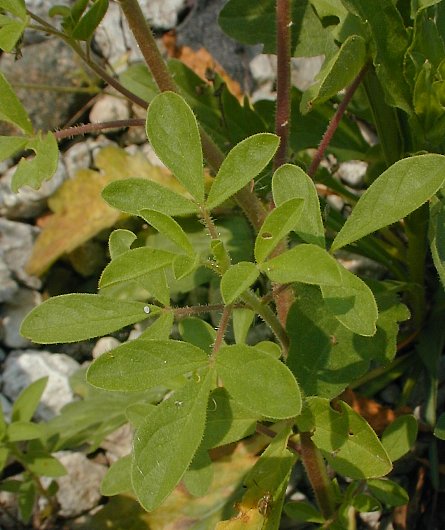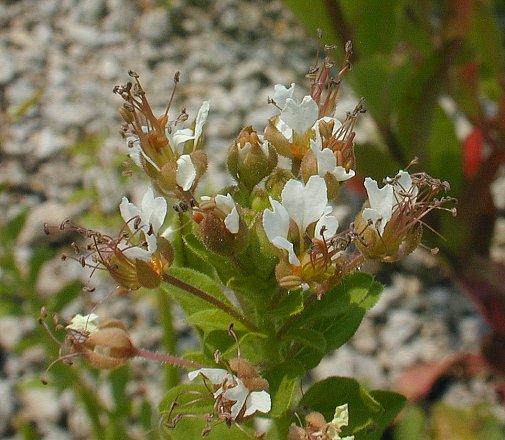Description: This plant is a summer annual about 1-2' tall that branches occasionally. The round stems are dull green to reddish purple and densely covered with sticky glandular hairs. The lower to middle leaves are trifoliate, while the upper leaves are simple; both types of leaves alternate along the stems. The simple leaves and leaflets of the trifoliate leaves are up to 1½" long ½" across; they are oblong, oval, or ovate in shape and smooth along the margins. The upper surface of each leaf or leaflet is pale green to green and covered with short fuzzy hairs, while longer hairs occur along the central vein of the lower surface. Each leaf has a petiole up to 1" long that is covered with sticky glandular hairs; it is dull green to reddish purple. The foliage exudes a fetid smell that is unpleasant. The central stem and some of the side stems terminate in racemes of flowers. The raceme of the central stem is up to one-half the length of the plant, while the racemes of the side stems (if any) are shorter. The flowers bloom at the apex of each raceme, while scattered seedpods and simple leaves lie below.

Each flower is about 1/3" (8 mm.) across, consisting of 4 white petals, 4 triangular sepals that are dull green to reddish purple, 8-12 stamens, and a reddish purple pistil. The petals are obovate or obcordate (heart-shaped) and up to ¼" long; they are erect, rather than spreading. Stamens are up to 1/3" (8 mm.) long and only slightly longer than the petals; they soon wither away after the flowers have been fertilized. The pedicel of each flower is dull green to reddish purple and covered with glandular hairs. The blooming period occurs during the summer and fall, and can last several months. Each fertilized flower is replaced by an oblongoid seedpod up to 2½" long that tapers at both ends; it has a short beak that quickly withers away, and no stipe at its base. The seedpods are covered with sticky glandular hairs; they are held erect along the central axis of each stem. Initially, the seedpods are dull green, but they later turn brown and split open to release their seeds. The root system consists of a taproot. This plant spreads by reseeding itself.

Cultivation:
The
preference is full sun, mesic to dry conditions, and a barren soil that
contains an abundance of sand, gravel, or clay. Drought tolerance is
excellent. This plant adapts to moist rich soil, but it is more likely
to sprawl.
Range & Habitat:
The native Clammyweed occurs occasionally throughout Illinois; it is a
little less
common in the southern part of the state (see Distribution
Map). Habitats include sand or gravel bars along rivers,
gravelly areas and clay banks along railroads, and barren waste areas.
It is possible that Clammyweed also occurs in disturbed areas of dry
sand prairies and gravel prairies. In Illinois, Clammyweed is more
common along railroads than anywhere else. It adapts well to highly
disturbed areas where there is scant ground vegetation.
Faunal Associations:
Little information is available about floral-faunal relationships for Polanisia
spp. (Clammyweeds). The small flowers probably attract small
bees, wasps, and flies. The fetid foliage is unlikely to be bothered by
most mammalian herbivores.

Photographic
Location:
Along a clay bank near a railroad in Champaign, Illinois.
Comments:
This odd plant is a distant relative of the commonly cultivated Cleome
hasserliana (Spider Flower), which is from South America. The
subspecies that is described here has smaller flowers than Polanisia
dodecandra trachysperma (Large-Flowered Clammyweed), and it
is less showy. The typical Clammyweed has flower petals about ¼" long
and stamens only a little larger, while Large-Flowered Clammyweed has
flower petals about ½" long and stamens up to twice as long as the
petals. Otherwise, these two subspecies are much the same. Clammyweeds
have flowers and foliage that are quite similar to Cleome spp.
The latter have flowers with only 4-6 stamens and their seedpods have
long stipes. The cultivated Spider Flower has palmate leaves with 5 or
more leaflets, whereas Clammyweeds and Cleome serrulata
(Rocky Mountain Bee Plant) have only trifoliate or simple leaves. These
species are all members of the Caper family. An older scientific name
for Clammyweed is Polanisia graveolens.